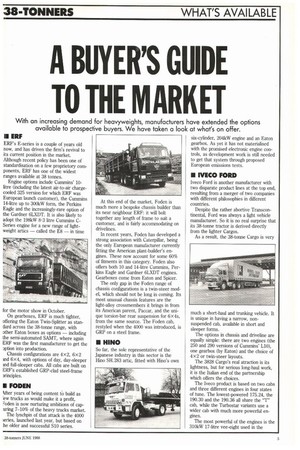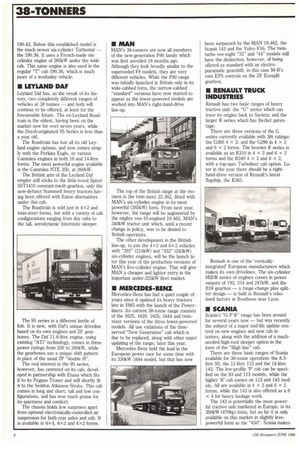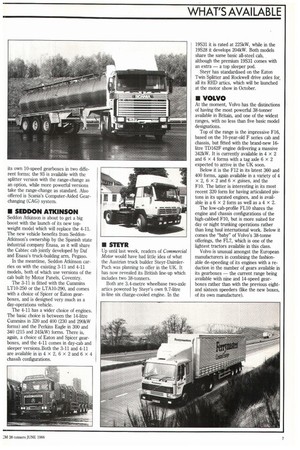A BUYER'S GUIDE TO THE MARKET
Page 113

Page 114

Page 115

If you've noticed an error in this article please click here to report it so we can fix it.
With an increasing demand for heavyweights, manufacturers have extended the options available to prospective buyers. We have taken a look at what's on offer.
• ERF
ERF's E-series is a couple of years old now, and has driven the firm's revival to its current position in the market. Although recent policy has been one of standardisation on a few proprietory components, ERF has one of the widest ranges available at 38 tonnes.
Engine options include 10litre (including the latest air-to-air chargecooled 325 version for which ERF was European launch customer), the Cununins 14-litre up to 300kW form, the Perkins Eagle and the increasingly-rare option of the Gardner 6LXDT. It is also likely to adopt the 198kW 8.3 litre Cummins CSeries engine for a new range of lightweight artics — called the E8 — in time for the motor show in October.
On gearboxes, ERF is much tighter, offering the Eaton Twin-Splitter as standard across the 38-tonne range, with other Eaton boxes as options — including the semi-automated SAMT, where again ERF was the first manufacturer to get the option into production.
Chassis configurations are 4x2, 6x2 Ind 6x4, with options of day, day-sleeper tnd full-sleeper cabs. All cabs are built on ERF's established GRP-clad steel-frame winciples.
• FODEN
kfter years of being content to build as ew trucks as would make it a profit, Foden is now nurturing ambitions of capruing 7-10% of the heavy trucks market.
The lynchpin of that attack is the 4000 ■ eries, launched last year, but based on he older and successful S10 series. At this end of the market, Foden is much more a bespoke chassis builder than its near neighbour ERF: it will bolt together any length of frame to suit a customer, and is fairly accommodating on drivelines.
In recent years, Foden has developed a strong association with Caterpillar, being the only European manufacturer currently fitting the American plant-builder's engines. These now account for some 60% of fitments in this category. Foden also offers both 10 and 14-litre Cummins, Perkins Eagle and Gardner 6LXDT engines. Gearboxes come from Eaton and Spicer.
The only gap in the Foden range of chassis configurations is a twin-steer model, which should not be long in corning. Its most unusual chassis features are the light-alloy crossmembers it brings in from its American parent, Paccar, and the unique torsion-bar rear suspension for 6x4s, from the same source. The Foden cab, restyled when the 4000 was introduced, is GRP on a steel frame.
• NINO
So far, the sole representative of the Japanese industry in this sector is the Hino SH.283 artic, fitted with Hino's own six-cylinder, 204kW engine and an Eaton gearbox. As yet it has not materialised with the promised electronic engine controls, as development work is still needed to get that system through proposed European emissions tests.
IVECO FORD
lveco Ford is another manufacturer with two disparate product lines at the top end, resulting from a merger of two companies with different philosophies in different countries.
Despite the rather abortive Transcontinental, Ford was always a light vehicle manufacturer. So it is no real surprise that its 38-tonne tractor is derived directly from the lighter Cargos.
As a result, the 38-tonne Cargo is very much a short-haul and trunking vehicle. It is unique in having a narrow, nonsuspended cab, available in short and sleeper forms.
The options in chassis and driveline are equally simple: there are two engines (the 250 and 290 versions of Cummins' L10), one gearbox (by Eaton) and the choice of 4x2 or twin-steer layouts.
The 3828 Cargo's real atraction is its lightness, but for serious long-haul work, it is the Italian end of the partnership which offers the choices.
The Iveco product is based on two cabs and three different engines in four states of tune. The lowest-powered 175.24, the 190.30 and the 190.36 all share the "T" cab, while the Turbostar variants use a wider cab with much more powerful engines.
The most powerful of the engines is the 310kW 17-litre vee-eight used in the 190.42. Below this established model is the much newer six-cylinder Turbostar — the 190.36. It uses a French-made sixcylinder engine of 265kW under the wide cab. This same engine is also used in the regular "T" cab 190.36, which is much more of a workaday vehicle.
• LEYLAND DAF
Leyland Daf has, as the result of its history, two completely different ranges of vehicles at 38 tonnes — and both will continue to be offered, at least for the foreseeable future. The ex-Leyland Roadtrain is the oldest, having been on the market now for over seven years, while the Dutch-originated 95 Series is less than a year old.
The Roadtrain has lost all its old Leyland engine options, and now comes simply with the Perkins Eagle, or various Cummins engines in both 10 and 14-litre forms. The most powerful engine available is the Cummins NTE 350, at 260kW.
The British arm of the Leyland Daf empire still sticks to the little-loved Spicer SST1410 constant-mesh gearbox, only the now-defunct Scammelt heavy tractors having been offered with Eaton alternatives under this cab.
The Roadtrain is sold just in 4x 2 and twin-steer forms, but with a variety of cab configurations ranging from day cabs to the tall, aerodynamic Interstate sleeper.
The 95 series is a different kettle of fish. It is new, with Dafs unique driveline based on its own engines and ZF gearboxes. The Daf 11.6-litre engine, using existing "ATi" technology, comes in three power ratings from 230 to 280kW, while the gearboxes use a unique shift pattern in place of the usual ZF "double H".
The real interest in the 95 series, however, has centered on its cab, developed in partnership with Enasa which fits it to its Pegaso Ironer and will shortly fit it to the Seddon Atkinson Strato. This cab comes in long and short, tall and low configurations, and has won much praise for its quietness and comfort.
The chassis holds few surprises apart from optional electronically-controlled air suspension for both rear axles and cab. It is available in 6x4, 6x2 and 4 X 2 forms.
• MAN
MAN's 38-tonners are now all members of the new-generation F90 family which was first unveiled 18 months ago. Although they look broadly similar to the superceded F8 models, they are very different vehicles. While the F90 range was initially launched in Britain only in its wide-cabbed form, the narrow-cabbed "standard" versions have now started to appear as the lower-powered models are worked into MAN's right-hand-drive line-up.
The top of the British range at the moment is the twin-steer 22.362, fitted with MAN's six-cylinder engine in its most powerful (265kW) form. From next year, however, the range will be augmented by the mighty vee-10-engined 19.462, MAN's 340kW tractor unit which, until a recent change in policy, was to be denied to British operators.
The other development in the British line-up, to join the 4 X 2 and 6x2 vehicles with "292" (214kW) and "332" (243kW) six-cylinder engines, will be the launch later this year of the production versions of MAN's five-cylinder engine. That will give MAN a cheaper and lighter entry in the important under-225kW fleet market.
• MERCEDES-BENZ
Mercedes-Benz has had a quiet couple of years since it updated its heavy tractors late in 1985 with the launch of the Powerliners. Its current 38-tonne range consists of the 1625, 1628, 1635, 1644 and twinsteer versions of the three lower-powered models. All use variations of the timeserved "New Generation" cab which is due to be replaced, along with other major updating of the range, later this year.
Mercedes-Benz held the lead in the European power race for some time with its 330kW 1644 model, but that has now been surpassed by the MAN 19.462, the Scania 143 and the Volvo F16. The twinturbo vee-eight "35" and "44" models still have the distinction, however, of being offered as standard with an electropneumatic gearshift, in this case M-B's own EPS controls on the ZF Ecosplit gearbox.
• RENAULT TRUCK INDUSTRIES
Renault has two basic ranges of heavy tractive unit: the "G" series which can trace its origins back to Saviem; and the larger R series which has Berliet parentage.
There are three versions of the G series currently available with 38t ratings: the G260 4 x 2; and the G290 in 4 x 2 and 6 x 2 forms. The heavier R series is available as an R310 in 4 x 2 and 6 x 2 forms and the R340 4 x 2 and 6 x 2, with a top-spec Turboliner cab option. Later in the year there should be a righthand-drive version of Renault's latest flagship, the R365.
Renault is one of the 'verticallyintegrated' European manufacturers which makes its own drivelines. The six-cylinder MIDR series of engines comes in power outputs of 192, 214 and 247kW, and the B18 gearbox — a range-change plus splitter design — is built in Renault's rohotised factory at Boutheon near Lyon.
• SCANUL
Scania's "G P R" range has been around for several years now — but was recently the subject of a-major mid-life update centred on new engines and new cab interiors, along with the addition of a muchneeded high-roof sleeper option in the form of the "High line" cab.
There are three basic ranges of Scania available for 38-tonne operation: the 8.5litre 93, the 11-litre 113 and the 14-litre 143. The low-profile `P cab can be specified on the 93 and 113 models, while the higher 'IV cab comes on 113 and 143 models. All are available in 4 X 2 and 6 x 2 forms, while the 143 is also offered as a 6 x 4 for heavy haulage work.
The 143 is potentially the most powerful tractive unit marketed in Europe, in its 350kW (470hp) form, but so far it is only available on this market in slightly lesspowerful form as the 1450. Scania makes its own 10-speed gearboxes in two different forms; the 93 is available with the splitter version with the range-change as an option, while more powerful versions take the range-change as standard. Also offered is Scania's Computer-Aided Gearchanging (CAG) system.
• SEDDON ATKINSON
Seddon Atkinson is about to get a big boost with the launch of its new topweight model which will replace the 4-11. The new vehicle benefits from SeddonAtkinson's ownership by the Spanish state industrial company Enasa, as it will share the Cabtec cab jointly developed by Daf and Enasa's truck-building arm, Pegaso.
In the meantime, Seddon Atkinson carries on with the existing 3-11 and 4-11 models, both of which use versions of the cab built by Motor Panels, Coventry.
The 3-11 is fitted with the Cummins LT10-250 or the LTA10-290, and comes with a choice of Spicer or Eaton gearboxes, and is designed very much as a day-operations vehicle.
The 4-11 has a wider choice of engines. The basic choice is between the 14-litre Cummins in 320 and 400 (230 and 290kW forms) and the Perkins Eagle in 300 and 340 (215 and 245kW) forms. There is, again, a choice of Eaton and Spicer gearboxes, and the 4-11 comes in day-cab and sleeper versions.Both the 3-11 and 4-11 are available in in 4 x 2, 6 x 2 and 6 x 4 chassis configurations.
• STEYR
Up until last week, readers of Commercial Motor would have had little idea of what the Austrian truck builder Steyr-DaimlerPuch was planning to offer in the UK. It has now revealed its British line-up which includes two 38-tonners.
Both are 3.4-metre wheelbase two-axle artics powered by Steyr's own 9.7-litre in-line six charge-cooled engine. In the 19S31 it is rated at 225kW, while in the 19528 it develops 204kW. Both models share the same basic all-steel cab, although the premium 19S31 comes with an extra — a top sleeper pod.
Steyr has standardised on the Eaton Twin Splitter and Rockwell drive axles forrn all its RHD arfics, which will be launched at the motor show in October.
• VOLVO
At the moment, Volvo has the distinctions of having the most powerful 38-tonner available in Britain, and one of the widest ranges, with no less than five basic model designations.
Top of the range is the impressive F16, based on the 10-year-old F series cab and chassis, but fitted with the brand-new 16litre TD162F engine delivering a massive 342kW. It is currently available in 4 x 2 and 6 x 4 forms with a tag axle 6 x 2 expected to arrive in the UK soon.
Below it is the F12 in its latest 360 and 400 forms, again available in a variety of 4 x 2, 6 x 2 and 6 x guises, and the F10. The latter is interesting in its most recent 320 form for having articulated pistons in its uprated engines, and is available in a 6 x 2 form as well as a 4 x 2.
The low-cab-profile FL10 shares the engine and chassis configurations of the high-cabbed F10, but is more suited for day or night trunking operations rather than long haul international work. Below it comes the "baby" of Volvo's 38-tonne offerings, the FL7, which is one of the lightest tractors available in this class.
Volvo is unusual amongst the European manufacturers in combining the fashionable de-speeding of its engines with a reduction in the number of gears available in its gearboxes — the current range being available with nine and 14-speed gearboxes rather than with the previous eightand sixteen speeders (like the new boxes, of its own manufacture).
























































































































































